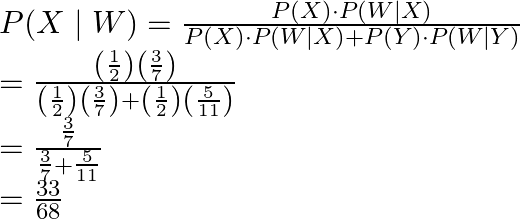Let ![]() : White ball
: White ball
B : Black ball

Assuming, selecting bags is of equal probability i.e. ![]()
We want to find ![]() , i.e. probability of selected white ball is from the
, i.e. probability of selected white ball is from the ![]() bag
bag

Therefore, the probability of selected white ball is from the ![]() bag is
bag is ![]()
There are two I and II. The bag I contains 3 white and 4 black balls, and bag II contains 5 white and 6 black balls. One ball is drawn at random from one of the bags and is found to be white. Find the probability that it was drawn from the bag I.
There are two I and II. The bag I contains 3 white and 4 black balls, and bag II contains 5 white and 6 black balls. One ball is drawn at random from one of the bags and is found to be white. Find the probability that it was drawn from the bag I.
